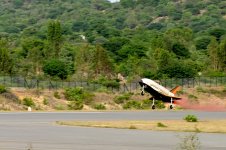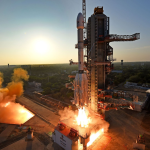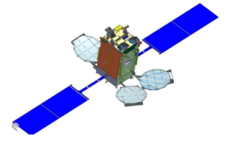Indian Space Program: News & Discussions
- Thread starter Tarun
- Start date
-
- Tags
- isro
You are using an out of date browser. It may not display this or other websites correctly.
You should upgrade or use an alternative browser.
You should upgrade or use an alternative browser.
How ISRO’s PSLV Integration Facility launch at Sriharikota will help India’s space ecosystem
Bengaluru: In an effort to increase the number of PSLV rocket launches and launches of other small vehicles, the Indian Space Research Organisation (ISRO) has built and formally launched a PSLV Integration Facility (PIF) in Andhra Pradesh’s Sriharikota.
The new facility, inaugurated by Prime Minister Narendra Modi Tuesday, will enable quicker assembly and integration of the PSLV (Polar Satellite Launch Vehicle) and smaller rockets at the launchpad. The complex is an augmentation of the First Launch Pad (FLP) at the Satish Dhawan Space Centre in Sriharikota.
The move is expected to increase PSLV launches annually, from about six to over double the number, at 12 or 15. Launches of customer satellites through India’s trustiest rocket PSLV are ISRO’s primary source of revenue. The PIF is also expected to help launch smaller rockets and private launch vehicles in the future.

How ISRO's PSLV Integration Facility launch at Sriharikota will help India’s space ecosystem
First of 3-part series looks at new facility opened by PM Modi Tuesday. It is expected to enable quicker assembly, integration of India’s trustiest rocket & smaller rockets at launchpad.
 theprint.in
theprint.in
Honourable Prime Minister Lays the Foundation Stone for India's Second Spaceport
In a momentous occasion for India's space ambitions, Hon’ble Prime Minister Shri Narendra Modi remotely laid the foundation stone for India's second spaceport at Kulasekharapattanam, a coastal village in Tamil Nadu's Thoothukudi district on February 28, 2024, at 09:45 hrs.
The selection of Kulasekharapattanam offers strategic advantages, particularly in enhancing payload capability with its direct southward launch trajectory for small launch vehicles.
The ceremony saw the esteemed presence of Shri Somanath S, Chairman, ISRO and Secretary, Department of Space (DoS), Dr. Pawan Kumar Goenka, Chairman, IN-SPACe and other senior officials.
The highlight of the event was the successful launch of the Rohini Sounding Rocket "RH200" from the newly established launch complex at 13:40 hrs IST. VSSC provided the rocket and the meteorological payload, while SDSC spearheaded the realization and installation of launch facilities including radars, launchers, and electronic systems.
The maiden launch from the new spaceport marked a significant milestone, with the RH200 rocket reaching a peak altitude of 75 km, precisely tracked by two on-site radars. The RH200 rocket, developed by VSSC, has a long-standing reputation for reliability, with this launch marking its 1928th successful mission.
Chairman, ISRO, Shri Somanath S., stated that today marks a historic day in the Indian space program as the Honorable PM laid the foundation for the second launch site, and a sounding rocket was successfully launched from the Kulasekharapattanam launch station. He further added that the launch site will be fully commissioned within 24 months and will enhance the space activities of NGEs.
Preparation for the RH200 Launch
The launch complex requirements were fulfilled through a comprehensive array of infrastructure facilities meticulously planned and executed within the shortest possible time at the new launch complex at Kulasai. The coordinated efforts of VSSC, IPRC, ISRO HQ, IISU, and SDSC-SHAR exemplified the cohesive teamwork within ISRO.
The RH 200 launch facilities were strategically laid out within the existing layout of SSLV facilities, adhering to stringent safety distance criteria. The sounding rocket launch pad coordinates were aligned with the IISU. Launchpad infrastructure, including integration & check-out facilities, assembly halls for preparation, and launch area services, were strategically grouped and sited into different zones considering functional requirements and local terrain.
The RH 200 launcher and associated systems were relocated from SDSC-SHAR and were erected, commissioned, and tested. Moreover, the portable radar of 10kw / 100µs pulse, a solid-state transmitter capable of tracking the chaff, was realized in-house with spare systems within two months. It underwent rigorous validation through continuous balloon-tracking trials.
For safe transportation of the RH 200 rocket within the launch complex, existing roads were augmented and strengthened, stretching approximately 3-4 km, transforming muddy roads into flight-worthy routes.
A comprehensive range-clearance procedure, safety and contingency plan, logistic arrangements, launch view galleries, medical facilities, fire tenders, and coastal boat patrolling, akin to SDSC-SHAR, were meticulously established, culminating in the safe and successful launch of the RH200.
Balloon Release Activities and Transportable Radar at Launch Complex at Kulasai


In a momentous occasion for India's space ambitions, Hon’ble Prime Minister Shri Narendra Modi remotely laid the foundation stone for India's second spaceport at Kulasekharapattanam, a coastal village in Tamil Nadu's Thoothukudi district on February 28, 2024, at 09:45 hrs.
The selection of Kulasekharapattanam offers strategic advantages, particularly in enhancing payload capability with its direct southward launch trajectory for small launch vehicles.
The ceremony saw the esteemed presence of Shri Somanath S, Chairman, ISRO and Secretary, Department of Space (DoS), Dr. Pawan Kumar Goenka, Chairman, IN-SPACe and other senior officials.
The highlight of the event was the successful launch of the Rohini Sounding Rocket "RH200" from the newly established launch complex at 13:40 hrs IST. VSSC provided the rocket and the meteorological payload, while SDSC spearheaded the realization and installation of launch facilities including radars, launchers, and electronic systems.
The maiden launch from the new spaceport marked a significant milestone, with the RH200 rocket reaching a peak altitude of 75 km, precisely tracked by two on-site radars. The RH200 rocket, developed by VSSC, has a long-standing reputation for reliability, with this launch marking its 1928th successful mission.
Chairman, ISRO, Shri Somanath S., stated that today marks a historic day in the Indian space program as the Honorable PM laid the foundation for the second launch site, and a sounding rocket was successfully launched from the Kulasekharapattanam launch station. He further added that the launch site will be fully commissioned within 24 months and will enhance the space activities of NGEs.
Preparation for the RH200 Launch
The launch complex requirements were fulfilled through a comprehensive array of infrastructure facilities meticulously planned and executed within the shortest possible time at the new launch complex at Kulasai. The coordinated efforts of VSSC, IPRC, ISRO HQ, IISU, and SDSC-SHAR exemplified the cohesive teamwork within ISRO.
The RH 200 launch facilities were strategically laid out within the existing layout of SSLV facilities, adhering to stringent safety distance criteria. The sounding rocket launch pad coordinates were aligned with the IISU. Launchpad infrastructure, including integration & check-out facilities, assembly halls for preparation, and launch area services, were strategically grouped and sited into different zones considering functional requirements and local terrain.
The RH 200 launcher and associated systems were relocated from SDSC-SHAR and were erected, commissioned, and tested. Moreover, the portable radar of 10kw / 100µs pulse, a solid-state transmitter capable of tracking the chaff, was realized in-house with spare systems within two months. It underwent rigorous validation through continuous balloon-tracking trials.
For safe transportation of the RH 200 rocket within the launch complex, existing roads were augmented and strengthened, stretching approximately 3-4 km, transforming muddy roads into flight-worthy routes.
A comprehensive range-clearance procedure, safety and contingency plan, logistic arrangements, launch view galleries, medical facilities, fire tenders, and coastal boat patrolling, akin to SDSC-SHAR, were meticulously established, culminating in the safe and successful launch of the RH200.
Balloon Release Activities and Transportable Radar at Launch Complex at Kulasai


This configuration seems to be similar to the Falcon 9 rocket.
The next stage of the RLV will be 60% larger and will be launched into orbit by the GSLV. It will have a door and solar panels to conduct experiments for a week before returning and landing on a runway.

ISRO all set for third reusable launch vehicle landing experiment
Taking its Reusable Launch Vehicle (RLV) programme one more step closer to reality, the Indian Space Research Organisation (ISRO) is all set to carry out the third and final RLV landing experiment (RLV LEX).
ISRO completes its RLV technology demonstrations through LEX trio
June 23, 2024

The Indian Space Research Organisation (ISRO) has proudly achieved a third consecutive success in the Reusable Launch Vehicle (RLV) Landing EXperiment (LEX) on June 23, 2024. The third and final test in the series of LEX (03) was conducted at 07:10 IST at the Aeronautical Test Range (ATR) in Chitradurga, Karnataka.

Following the success of the RLV LEX-01 and LEX-02 missions, RLV LEX-03 re-demonstrated the autonomous landing capability of the RLV under more challenging release conditions (cross range of 500 m against 150 m for LEX-02) and more severe wind conditions. The winged vehicle, named ‘Pushpak’, was released from an Indian Air Force Chinook Helicopter at an altitude of 4.5 km. From a release point 4.5 km away from the runway, Pushpak autonomously executed cross-range correction manoeuvres, approached the runway and performed a precise horizontal landing at the runway centreline.
Due to this vehicle’s low lift-to-drag ratio aerodynamic configuration, the landing velocity exceeded 320 kmph, compared to 260 kmph for a commercial aircraft and 280 kmph for a typical fighter aircraft. After touchdown, the vehicle velocity was reduced to nearly 100 kmph using its brake parachute, after which the landing gear brakes were employed for deceleration and stop on the runway. During this ground roll phase, Pushpak utilises its rudder and nose wheel steering system to autonomously maintain a stable and precise ground roll along the runway.

This mission simulated the approach and landing interface and high-speed landing conditions for a vehicle returning from space, reaffirming ISRO’s expertise in acquiring the most critical technologies required for the development of a Reusable Launch Vehicle (RLV). Through this mission, the advanced guidance algorithm catering to longitudinal and lateral plane error corrections, which is essential for the future Orbital Re-entry Mission has been validated. The RLV-LEX uses multisensor fusion including sensors like Inertial sensor, Radar altimeter, Flush air data system, Pseudolite system and NavIC. Notably, the RLV-LEX-03 mission reused the winged body and flight systems as such without any modification, from the LEX-02 mission, demonstrating the robustness of ISRO's capability of design to reuse flight systems for multiple missions.
This mission simulates the approach & landing interface and high-speed landing conditions for a vehicle returning from space, which will reaffirm ISRO’s expertise in acquiring the most critical technologies required for the development of a Reusable Launch Vehicle (RLV).

The mission, led by VSSC, was a collaborative effort involving multiple ISRO centres SAC, ISTRAC, SDSC-SHAR, with significant support from the Indian Air Force (IAF), Aeronautical Development Establishment (ADE), Aerial Delivery Research and Development Establishment (ADRDE), Regional Centre for Military Airworthiness (RCMA) under Centre for Military Airworthiness and Certification (CEMILAC), National Aerospace Laboratories (NAL), Indian Institute of Technology, Kanpur, Indian aerospace industrial partners, Indian Oil Corporation of India and Airport Authority of India.
Shri. S Somanath, Chairman, ISRO/Secretary, Department of Space, congratulated the team for their efforts in maintaining the success streak in such complex missions. Dr. S Unnikrishnan Nair, Director of VSSC, emphasised that this consistent success boosts ISRO's confidence in the critical technologies essential for future orbital re-entry missions.
Shri. J Muthupandian is the Mission Director and Shri. B Karthik is the Vehicle Director for this successful mission.
ISRO completes its RLV technology demonstrations through LEX trio




















